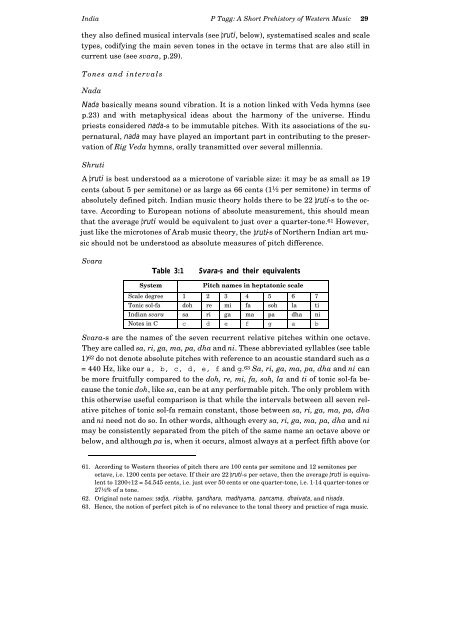A Short Prehistory of Western Music, Chapter 3
A Short Prehistory of Western Music, Chapter 3
A Short Prehistory of Western Music, Chapter 3
Create successful ePaper yourself
Turn your PDF publications into a flip-book with our unique Google optimized e-Paper software.
India P Tagg: A <strong>Short</strong> <strong>Prehistory</strong> <strong>of</strong> <strong>Western</strong> <strong>Music</strong> 29<br />
they also defined musical intervals (see þruti, below), systematised scales and scale<br />
types, codifying the main seven tones in the octave in terms that are also still in<br />
current use (see svara, p.29).<br />
Tones and intervals<br />
Nada<br />
Nada basically means sound vibration. It is a notion linked with Veda hymns (see<br />
p.23) and with metaphysical ideas about the harmony <strong>of</strong> the universe. Hindu<br />
priests considered nada-s to be immutable pitches. With its associations <strong>of</strong> the supernatural,<br />
nada may have played an important part in contributing to the preservation<br />
<strong>of</strong> Rig Veda hymns, orally transmitted over several millennia.<br />
Shruti<br />
A þruti is best understood as a microtone <strong>of</strong> variable size: it may be as small as 19<br />
cents (about 5 per semitone) or as large as 66 cents (1½ per semitone) in terms <strong>of</strong><br />
absolutely defined pitch. Indian music theory holds there to be 22 þruti-s to the oc-<br />
tave. According to European notions <strong>of</strong> absolute measurement, this should mean<br />
that the average þruti would be equivalent to just over a quarter-tone. 61 However,<br />
just like the microtones <strong>of</strong> Arab music theory, the þruti-s <strong>of</strong> Northern Indian art mu-<br />
sic should not be understood as absolute measures <strong>of</strong> pitch difference.<br />
Svara<br />
Table 3:1 Svara-s and their equivalents<br />
System Pitch names in heptatonic scale<br />
Scale degree 1 2 3 4 5 6 7<br />
Tonic sol-fa doh re mi fa soh la ti<br />
Indian svara sa ri ga ma pa dha ni<br />
Notes in C c d e f g a b<br />
Svara-s are the names <strong>of</strong> the seven recurrent relative pitches within one octave.<br />
They are called sa, ri, ga, ma, pa, dha and ni. These abbreviated syllables (see table<br />
1) 62 do not denote absolute pitches with reference to an acoustic standard such as a<br />
= 440 Hz, like our a, b, c, d, e, f and g. 63 Sa, ri, ga, ma, pa, dha and ni can<br />
be more fruitfully compared to the doh, re, mi, fa, soh, la and ti <strong>of</strong> tonic sol-fa because<br />
the tonic doh, like sa, can be at any performable pitch. The only problem with<br />
this otherwise useful comparison is that while the intervals between all seven relative<br />
pitches <strong>of</strong> tonic sol-fa remain constant, those between sa, ri, ga, ma, pa, dha<br />
and ni need not do so. In other words, although every sa, ri, ga, ma, pa, dha and ni<br />
may be consistently separated from the pitch <strong>of</strong> the same name an octave above or<br />
below, and although pa is, when it occurs, almost always at a perfect fifth above (or<br />
61. According to <strong>Western</strong> theories <strong>of</strong> pitch there are 100 cents per semitone and 12 semitones per<br />
octave, i.e. 1200 cents per octave. If their are 22 þruti-s per octave, then the average þruti is equivalent<br />
to 1200÷12 = 54.545 cents, i.e. just over 50 cents or one quarter-tone, i.e. 1·14 quarter-tones or<br />
27½% <strong>of</strong> a tone.<br />
62. Original note names: sadja, risabha, gandhara, madhyama, pancama, dhaivata, and nisada.<br />
63. Hence, the notion <strong>of</strong> perfect pitch is <strong>of</strong> no relevance to the tonal theory and practice <strong>of</strong> raga music.














